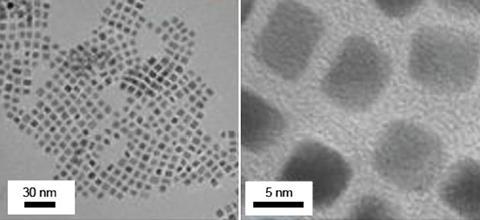‘Dial-a-particle’ strategy tunes the size and shape of nanostructures
A new flow-based reactor has helped researchers from the US slash the time required to synthesise nanocrystals from many hours to just a couple of minutes – whilst still maintaining precise control over their shapes.

The increased prevalence of nanomaterials across chemical industries has highlighted a need to better regulate their synthesis. Catalytic processes in particular require very specific crystal surfaces, so it is vital to grow nanocrystals in an accurate manner to maximise their effectiveness.
Batch reactors are the traditional workhorses of nanomaterial synthesis. ‘We realised how difficult it was to produce these materials according to the conventional methods,’ explains Victor Sebastian, one of the members of Klavs Jensen’s team from the Massachusetts Institute of Technology behind the project. ‘It’s difficult to control the mixing [of reagents] and temperature changes.’ Nanosynthesis expert Christina Graf, from the Free University of Berlin, Germany, who was not involved in the research, elaborates: ‘Known approaches are usually rather slow, and syntheses carried out in batch reactors often yield varying products and relatively small yields.’
Dubbed a ‘dial-a-particle’ strategy, the team’s microfluidic flow reactor changes the gaseous reagent, the residence time, or the reaction temperature, to tune the nanocrystals’ shape and size. The superior circulation of reagents within flow systems provides greater control over key nucleation and growth steps, meaning the same reactor can make entirely different nanoparticles. It takes only minutes to alter the reaction conditions.
The rapid nature of this process is a massive advantage. ‘The syntheses we report are run in less than 150 seconds,’ remarks Sebastian. ‘Some of the reported protocols in batch reactors are run in a matter of hours. So we can drastically reduce the synthesis time, but, we have really good control of the material – this is the real difference.’
‘I think the work’s most exciting aspect is the potential to create a combinatorial system that would have many of these microfluidic reactors working in parallel to explore a wide range of synthetic parameters,’ comments nanotechnology specialist Brian Korgel, from the University of Texas, US. ‘You could integrate the microfluidic reactors into such a system and it would provide dramatically higher throughput.’
Sebastian is equally enthusiastic about the future. ‘I would like us to go deeper. We could produce new materials not yet discovered – with new properties – this will be really challenging and interesting.’
References
This article is free to access until 13 April 2016
V Sebastian, C D Smith and K F Jensen, Nanoscale, 2016, DOI: 10.1039/c5nr08531d












No comments yet